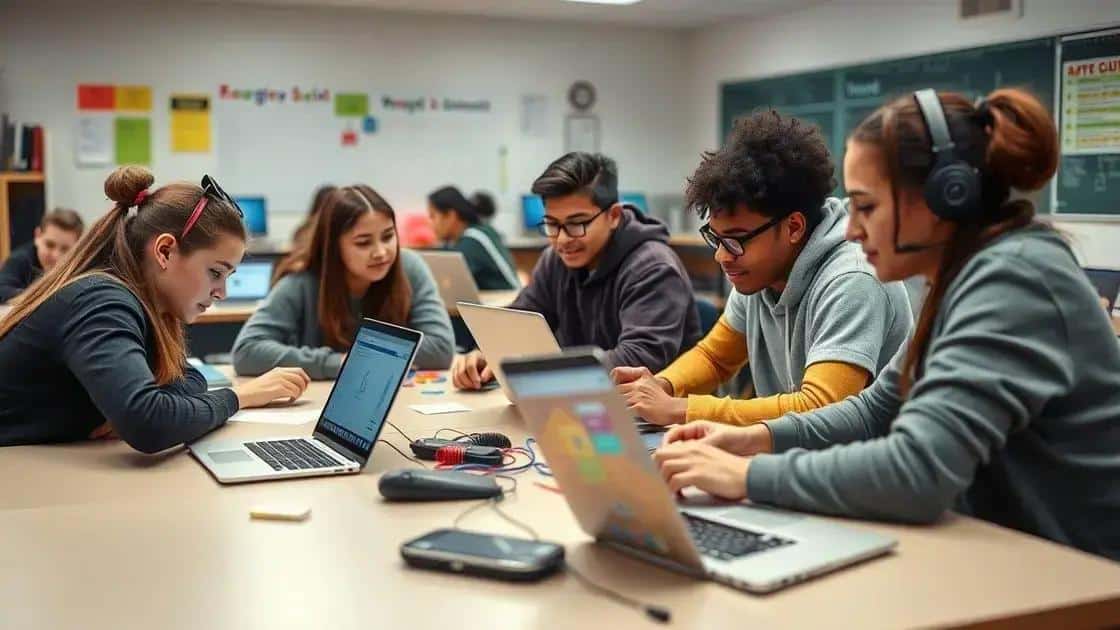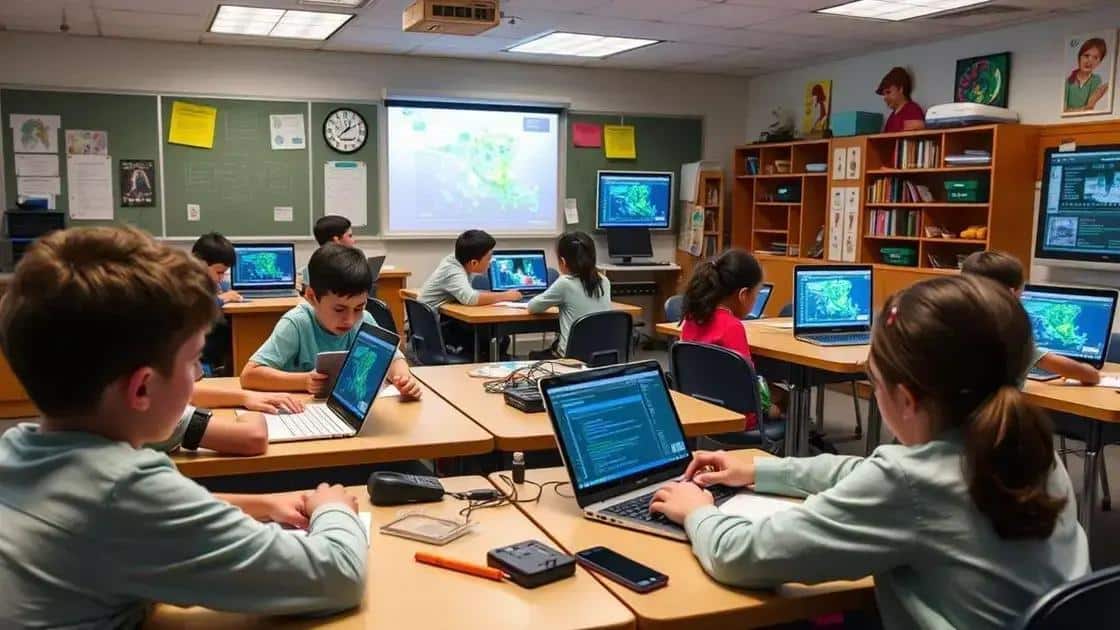High school coding classes trends shaping the future

Integrating coding into high school education enhances problem-solving, creativity, and critical thinking skills while preparing students for various future career opportunities in a technology-driven world.
High school coding classes trends are becoming increasingly popular as educators recognize their importance. Have you ever wondered how learning to code can impact a student’s future career opportunities? Let’s dive into the evolving landscape of coding education.
The rise of coding classes in high schools
The rise of coding classes in high schools is changing how students approach technology. As the world becomes more digital, schools are adapting to prepare students for future careers. This shift not only encourages creativity but also helps develop key problem-solving skills. Students today are expected to understand programming to succeed in many industries.
Why Schools Are Embracing Coding
Many high schools are now recognizing the importance of teaching coding. Educators see coding as a vital skill in our tech-driven society. Schools are integrating coding programs into their curricula to enhance learning.
Benefits of Coding Classes
- Improves logical thinking and problem-solving skills
- Encourages teamwork and collaboration
- Prepares students for future job opportunities
- Enhances creativity through interactive projects
By participating in coding classes, students gain hands-on experience. They learn to create games, apps, and websites, which can be both fun and educational. These practical applications motivate students and show them the relevance of coding in real life.
Types of Coding Classes Offered
High schools offer various coding courses, including introductory programming, web development, and game design. Each course serves as a building block for advanced topics like artificial intelligence and machine learning. Such diversity allows students to explore different interests within the tech field.
Through these classes, students not only gain technical skills but also learn the value of perseverance and innovation. Coding is not simply about writing lines of code; it’s about embracing challenges and developing solutions. This mindset is crucial for success in any career.
Skills students gain from coding programs

Coding programs in high schools are not just about learning to write code; they provide students with valuable skills that extend beyond the classroom. As technology continues to evolve, the need for technical skills is more critical than ever. Students who engage in coding gain a variety of competencies that prepare them for future challenges and careers.
Key Skills Developed
Through coding classes, students learn essential skills that help them succeed. These include:
- Problem-solving: Coding challenges require students to think critically and find solutions to complex issues.
- Logical thinking: Learning coding fosters a structured way of thinking, which is crucial in various fields.
- Creativity: Coding projects allow students to express their creativity while building functional software or games.
- Collaboration: Many coding assignments are team-based, teaching students how to work effectively with others.
Students also develop an understanding of how technology works. This knowledge gives them a stronger grasp of digital tools they will encounter in the workforce. They learn to embrace failure and iterate on their projects, an important lesson in resilience.
Real-world Applications of Coding Skills
These skills are transferable to many areas of life and work. For example, in fields like healthcare, engineering, and finance, professionals often rely on coding to analyze data and develop solutions. Moreover, coding enhances communication skills as students explain their ideas and work to peers and instructors.
As students build coding projects, they often work on real-world challenges. This practical experience is invaluable, giving them a taste of what to expect in their future careers. They learn to manage projects, meet deadlines, and communicate effectively with team members, all while having fun and being creative.
Impact of coding on future career paths
The impact of coding on future career paths is significant and wide-reaching. As industries continue to embrace technology, the ability to code becomes a vital skill for many jobs. Students who learn coding are positioning themselves for success in a digital world.
Career Opportunities in Tech
Coding opens doors to numerous career options in the technology industry. Some of the most popular fields include:
- Software development: Creating applications and systems for various platforms.
- Web development: Designing and building websites for personal or business use.
- Data analysis: Interpreting complex data sets to inform business decisions.
- Game development: Combining creativity and code to create engaging video games.
The demand for skilled programmers is high. Many companies seek individuals who can create innovative solutions or streamline processes. This demand ensures that those with coding skills often enjoy a competitive edge in the job market.
Transferable Skills Beyond Coding
Moreover, coding isn’t just for tech jobs. The skills learned through coding classes are valuable in various fields. Understanding coding helps in roles like marketing, healthcare, and finance. Employees who grasp basic coding concepts can communicate effectively with tech teams.
Coding also fosters critical thinking and problem-solving. These skills are essential in any profession. As students navigate coding challenges, they learn to break down problems, think logically, and devise solutions. This mindset applies to challenges encountered in various careers.
In summary, the impact of coding on career paths is profound. As technology continues to advance, individuals with coding skills will have more opportunities and the ability to thrive in an ever-changing job landscape. Embracing coding education now can lead to numerous possibilities in the future.
Integrating coding with traditional subjects

Integrating coding with traditional subjects is an innovative approach that enhances learning. Many educators are finding ways to incorporate coding into subjects like math, science, and even art. This integration helps students see the relevance of coding in various fields, making their education more engaging and practical.
Benefits of Integration
This approach offers numerous advantages. By blending coding with traditional subjects, students are able to:
- Understand concepts better: Coding can clarify complex ideas in subjects like mathematics, where algorithms and functions apply directly.
- Develop critical thinking: Students learn to think analytically as they tackle coding projects tied to real-world scenarios in science or history.
- Enhance creativity: Coding can enhance creativity in art classes, where students can program animations or interactive art installations.
- Encourage collaboration: Working on interdisciplinary projects often involves teamwork, allowing students to learn from each other.
When coding is introduced alongside traditional subjects, it allows learners to apply their knowledge in versatile ways. For instance, in a science class, students might create simulations to test hypotheses. In math, they could develop programs to solve equations or graph functions, making abstract concepts more tangible.
Practical Application Examples
Educators are finding creative methods to implement integration effectively. In history classes, students might use coding to create interactive timelines or digital storytelling platforms. In language arts, they can develop storytelling apps that perform text-to-speech functions.
The possibilities are limited only by the students’ imagination. This fusion of subjects prepares students for modern careers, where such flexibility in thinking and problem-solving is crucial. By overcoming traditional boundaries in education, students gain skills that will be invaluable in the future.
Conclusion: Integrating coding into traditional subjects transforms education. It enhances students’ problem-solving skills, creativity, and critical thinking. As schools embrace this approach, learners not only grasp core concepts better but also prepare for a future filled with diverse career opportunities. By merging coding with subjects like math, science, and art, students become more engaged and equipped for success. This shift in education is crucial as it reflects the demands of the modern workforce, making coding an essential skill for all learners.
FAQ – Frequently Asked Questions about Coding in High School
Why is coding important in high school?
Coding is essential because it enhances problem-solving skills and prepares students for technology-driven careers.
How can coding integrate with traditional subjects?
Coding can be combined with subjects like math, science, and art to make learning more engaging and relatable.
What skills do students gain from coding classes?
Students develop critical thinking, creativity, and collaboration skills while learning to code.
What career opportunities can arise from learning to code?
Learning to code opens doors to careers in software development, data analysis, web design, and more.





